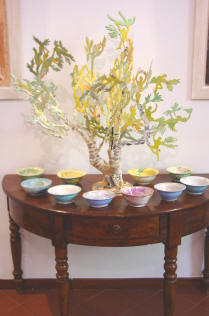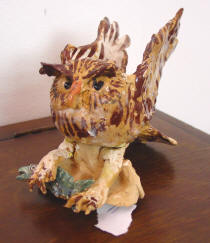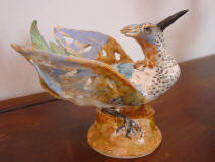arts section - August 31, 2005
Ann Stokes has been crafting creatures for half a century. Our correspondent visits her menagerie
Ann Stokes is a potter and ceramicist, and this is the studio in which she has been working for 50 years. Aged 82, she is still working there as hard as ever, and downstairs in her kitchen, over a cup (a very pretty cup) of tea, she told me how it all began. As we talked, I could hardly keep my eyes off the exquisite plates on the dresser, terracotta and green and decorated with dandelion and nettle leaves.
At the beginning of the Second World War, when she was 17, she was in Cornwall, and there she met the artist Adrian Stokes, later famous not only for his landscape paintings but also for his writings on art. He encouraged her to take up ballet, which she did — at an evacuated ballet school — and she instantly loved it. But she had damaged her right instep when she fell off a horse as a child, and she realised she would never have a career as a dancer. So after the war (which she spent in the WRNS), she gave up ballet and married Stokes.
When they moved to London and into this Hampstead house, she looked for something to interest her eight-year-old son, and found a potter who could teach him how to work in clay. He gave it up after a year, but by then she had started learning, too — and loving it as much as ballet. At 34 her lifelong career began.But it was not the end of ballet for her. By doing ballet, Stokes had learned what line and balance are, and it was line and balance that she brought to her new art. “My birds and my trees are now my ballet dancers,” she said. She showed me a little jug for pouring olive oil that she had made, in the form of a bird, and as I took it from her hands it was clear at once what she meant. The line of the bird was beautiful, and the balance as you poured a little oil from it was perfect.
We went back up to her studio, dominated for me by that osprey. It was amazing how she had moulded this magnificent bird, with its great head and beak, its wings spread wide, and its utterly convincing air of hovering fiercely over us. The crocodile was also a formidable presence. Stokes often goes to the zoo to make drawings of animals she wants to make, and she had spent days giving the croc its strange, rugged skin.
On shelves everywhere there were smaller figures, especially birds. “I’ve done hundreds of hoopoes,” she said, lifting one down. Adrian Stokes died in 1972, and Ann and her second husband, Ian Angus, have a house in Tuscany, where she makes Italian birds such as the hoopoes. Among all the figures, I was surprised to see the 20-volume edition of George Orwell’s works on the mantelpiece. The explanation: Angus is an Orwell scholar, and, with Orwell’s wife Sonia, edited the first four-volume edition of his essays and letters, as well as advising on the 20 volumes.
Stokes has another craft: fretwork. She started with a little hand fretsaw, but now she has a power tool in her studio. The black and white birds I had seen through the door were made of wood, and the trunk, about 4ft high, was pottery — and the birds and branches danced. In fact, the tree could be turned round electrically, so that now the white sides of the birds showed, now the black. It was ballet yet again.
Stokes sells her work nowadays through the Rebecca Hossack Gallery in London W1, but for years she sold it just from the house. She had her first show at home in 1958 with another potter friend, Mary Day Wollheim, and when they added up how much they had taken they found to their amazement that they had each made exactly 16 pounds and eightpence-halfpenny.
Many people collect her work, including Lord Ravensdale, better known as the novelist Nicholas Mosley, who has one copy of everything she has made. The Prince of Wales once visited her with a friend in Italy, and the friend bought one of Stokes’s plates for the Prince. But what she most remembers from that visit is the Prince (whose entourage had brought some ham sandwiches) saying how nice Italian food was. “It can quickly get boring,” Stokes said, and he replied, sadly, “I am never anywhere long enough for anything to get boring”.
It made her feel sorry for royalty. Stokes’s wheel in Hampstead is under her window, and her kiln is in the old wine cellar beneath the pavement. They have been her daily companions for half a century, but they are something she has never got bored with.


